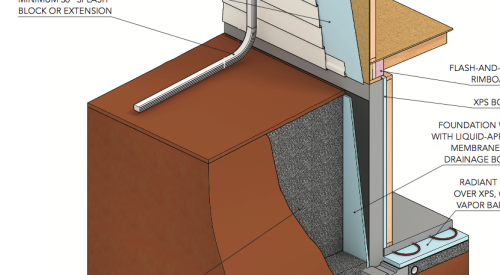The easier the maintenance, the more likely your homes will reflect quality 10, 20 or 50 years from now. Here's a checklist for "smart durability" - building practices that can improve durability by easing the maintenance burden.
Design for moisture. The biggest threat to a home's exterior is moisture. Important moisture-control measures include keeping obstructions such as dormers and chimneys away from valleys to avoid blocking water flow; using kick-out flashing where an eave runs into a wall; using rain-screen wall construction; overlapping moisture barriers to drain outward; flashing to the outside at any obstruction in the moisture barrier; using flexible pan flashing under all windows; and sending roof water away from the house with downspout extensions and a sloping grade.
Choose exhaust fans that don't penalize users. Bathroom fans that sound like idling trucks rarely get used. Installing quiet, efficient fans can reduce moisture significantly, which in turn can improve the durability of other house components. Install a delay timer to enhance the benefit. Pay attention to kitchen exhaust, too. A motor on the outside of the house can make the kitchen much quieter. And observe code requirements in venting all exhaust fans outdoors.
| With funding from PATH, researchers at NIST’s Building and Fire Research Laboratory are working to speed the introduction of more durable products into the market. The revolutionary NIST Sphere accelerates weathering by generating controlled temperature, humidity and ultraviolet exposure environments up to 50 times faster than outdoor weathering. |
Locate the water heater near a floor drain. Maintenance will be easier and therefore more likely to happen if the homeowner or plumber doesn't have to haul buckets.
Make electrical panels easy to reach. If the box is hard to access, maintenance probably won't happen until something breaks.
Install shut-off valves with a busy household in mind. With a plumbing manifold and cross-linked polyethylene (PEX) piping system, hot- and cold-water shut-offs to each appliance and every sink are in one central place. Appliance maintenance and replacing faucet valves won't require shutting down other fixtures.
Install J-channel siding corners. Available for vinyl, aluminum and fiber-cement siding, these corners eliminate a maintenance step because there's no caulking to replace. Homes become easier to finish, and the corners add nothing to installation time.
Invest in quality materials. Under linoleum, for example, use underlayment-grade plywood (1/2 inch or thicker) approved by APA-The Engineered Wood Association, or use cement board. Refrigerators and ranges won't crush the subfloor, saving maintenance down the road. Choose products that wear well, which might mean ceramic tile rather than hardwood in some locations.
Minimize roof penetrations. Every one is a potential leak. This requires planning but pays off in faster installation and a cleaner roof line. Cut the number of penetrations by opting for ridge vents instead of exhaust vents. If allowed by local code, place vents in side walls or gable ends instead of through roofs. Save a plumbing vent by using an air admittance valve instead.
Design for smart plumbing. Stack bathrooms to keep piping simple. If pinhole leaks develop in the future, stacking can avoid a massive repair job.
Educate home buyers about durability with the help of tools such as the Durability Doctor. A new PATH tool developed by researchers at the National Institute of Standards and Technology, the Durability Doctor offers a powerful way to demonstrate to home buyers why some products are better choices than others. Given a home's structure, materials and location, the software lets users easily measure the durability and economics of various building material selections. The most economical choices in terms of initial cost can be weighed against the most durable choices, which often provide more long-term value. Visit www.pathnet.org to download the tool.
Smart durability practices entail removing homeowner disincentives to maintenance while taking a principled approach to built-in quality. They are one more way to raise your profile in a crowded marketplace.
|









